
R-Type is a horizontally scrolling shooter arcade video game developed and released by Irem in 1987 and the first game in the R-Type series. The player controls a star ship, the R-9 "Arrowhead", in its efforts to destroy the Bydo, a powerful alien race bent on wiping out all of mankind. The R-9 can acquire a glowing orbicular device called a "Force", protecting it from enemy fire and providing additional firepower. The arcade version was distributed by Nintendo in North America; it is the last arcade title Nintendo distributed.

Arkanoid is a 1986 block breaker arcade game developed and published by Taito. In North America, it was published by Romstar. Controlling a paddle-like craft known as the Vaus, the player is tasked with clearing a formation of colorful blocks by deflecting a ball towards it without letting the ball leave the bottom edge of the playfield. Some blocks contain power-ups that have various effects, such as increasing the length of the Vaus, creating several additional balls, or equipping the Vaus with cannons. Other blocks may be indestructible or require multiple hits to break.

Snood is a puzzle video game programmed by Dave Dobson. Snood was released for Mac OS in 1996 as shareware, then for MS-DOS and Microsoft Windows in 1999. An adaptation for Game Boy Advance was developed by Rebellion Developments and released by Destination Software in 2001, and an iOS version was developed by Iron Galaxy and released by EA Mobile on May 8, 2009. Dobson founded Snood, LLC to sell the game.

Microsoft Paint is a simple raster graphics editor that has been included with all versions of Microsoft Windows. The program opens, modifies and saves image files in Windows bitmap (BMP), JPEG, GIF, PNG, and single-page TIFF formats. The program can be in color mode or two-color black-and-white, but there is no grayscale mode. For its simplicity and wide availability, it rapidly became one of the most used Windows applications, introducing many to painting on a computer for the first time.

Breakout is an arcade video game developed and published by Atari, Inc. and released on May 13, 1976. It was designed by Steve Wozniak, based on conceptualization from Nolan Bushnell and Steve Bristow, who were influenced by the seminal 1972 Atari arcade game Pong. In Breakout, a layer of bricks lines the top third of the screen and the goal is to destroy them all by repeatedly bouncing a ball off a paddle into them. The arcade game was released in Japan by Namco. Breakout was a worldwide commercial success, among the top five highest-grossing arcade video games of 1976 in both the United States and Japan and then among the top three highest-grossing arcade video games of 1977 in the US and Japan. The 1978 Atari VCS port uses color graphics instead of a monochrome screen with colored overlay.
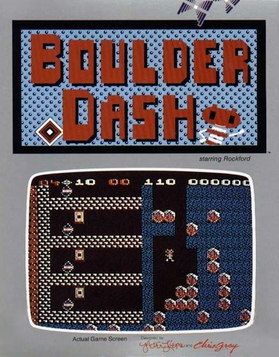
Boulder Dash is a maze-based puzzle video game released in 1984 by First Star Software for Atari 8-bit computers. It was created by Canadian developers Peter Liepa and Chris Gray. The player controls Rockford, who tunnels through dirt to collect diamonds. Boulders and other objects remain fixed until the dirt beneath them is removed, then they fall and become a hazard. Puzzles are designed around collecting diamonds without being crushed and exploiting the interactions between objects. The game's name is a pun on balderdash.
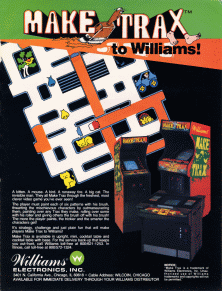
Make Trax, originally released in Japan as Crush Roller, is a 1981 maze game developed by Alpha Denshi and published as an arcade video game by Kural Samno Electric in Japan. It was licensed in Europe to Exidy, which released it under its original title Crush Roller, and in North America to Williams Electronics, who released it as Make Trax.
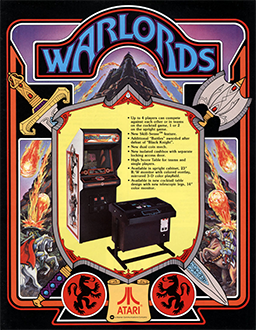
Warlords is an arcade video game released by Atari, Inc. in 1980. The game resembles a combination of Breakout and Quadrapong. Up to four players are able to play the game at the same time and the "castles" in the four corners of the screen are brick walls that can be destroyed with a flaming ball.

Tron is a coin-operated arcade video game manufactured and distributed by Bally Midway in 1982. The game consists of four subgames inspired by the events of the Walt Disney Productions film Tron released earlier in the summer. The lead programmer was Bill Adams with Earl Vickers programming the music. The game was a major success, with approximately 10,000 arcade cabinets sold, and it was awarded "Coin-Operated Game of the Year" by Electronic Games.

Mr. Do! is a 1982 maze video game developed by Universal. It is the first arcade video game to be released as a conversion kit for other cabinets; Taito published the conversion kit in Japan. The game was inspired by Namco's Dig Dug released earlier in 1982. Mr. Do! was a commercial success in Japan and North America, selling 30,000 arcade units in the US, and it was followed by several arcade sequels.

Quake Army Knife (QuArK) is a free and open-source program for developing 3D assets for a large variety of first-person shooters, such as video games using the Quake engine by id Software or the Torque engine.

Full Tilt! Pinball, known as Pinball 95 in Europe, is a 1995 pinball video game developed by Cinematronics and published by Maxis. It features pre-rendered 3D graphics and three tables: Space Cadet, Skulduggery, and Dragon's Keep. A sequel called Full Tilt! Pinball 2 was released in 1996.

Terminal Velocity is a shooter video game originally developed by Terminal Reality and published by 3D Realms for DOS and Windows 95, and MacSoft for Mac OS. It is an arcade-style flight combat game, with simpler game controls and physics than flight simulators. It is known for its fast, high-energy action sequences, compared to flight simulators of the time.
VG Pocket is a series of handheld dedicated game consoles built by JungleTac and sold by Performance Designed Products LLC. The VG Pocket model was the first console of its type to have a 2" backlit color LCD screen.
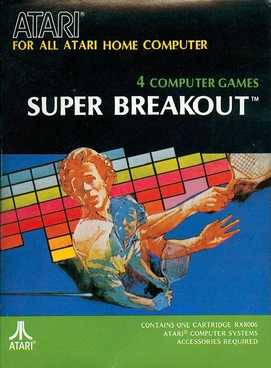
Super Breakout is a sequel to the 1976 video game Breakout released in arcades in September 1978 by Atari, Inc. It was written by Ed Rotberg. The game uses the same mechanics as Breakout, but allows the selection of three distinct game modes via a knob on the cabinet—two of which involve multiple, simultaneous balls in play. Both the original and sequel are in black and white with monitor overlays to add color. It was distributed in Japan by Namco and Esco Trading.
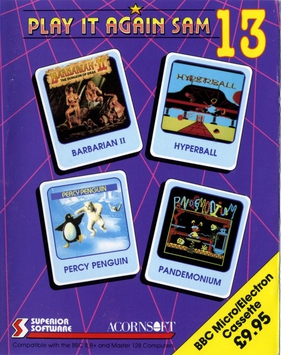
Hyperball is a clone of the 1986 arcade game Arkanoid created for the Acorn Electron and BBC Micro. It was released as part of the compilation Play It Again Sam 13 in 1990.

Welltris is a puzzle video game, developed by Doka and licensed to Bullet-Proof Software. It is an official game in the Tetris series. Adaptations were made by Sphere, Inc., for Spectrum HoloByte, and by Infogrames. It was released for MS-DOS compatible operating systems in 1989. Ports for Macintosh, Amiga, Amstrad CPC, and Atari ST followed in 1990, then ZX Spectrum and Commodore 64 in 1991.
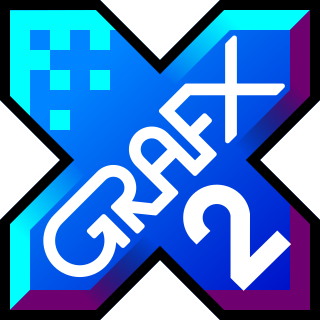
GrafX2 is a bitmap graphics editor inspired by the Amiga programs Deluxe Paint and Brilliance. It is free software and distributed under the GPL-2.0-only license.
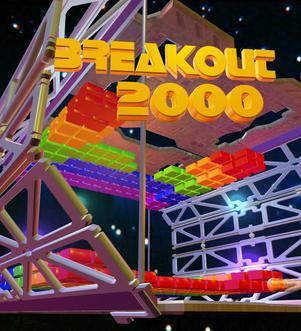
Breakout 2000 is a 1996 action video game developed by MP Games and published by Telegames for the Atari Jaguar. Part of the 2000 series by Atari Corporation, it is a remake of the arcade game Breakout (1976), and one of the last officially licensed releases for the platform. Featuring a similar premise to Breakout, the player must destroy a layer of brick lines by repeatedly bouncing a ball spawned off a paddle into them and keep it in play. Gameplay modifications to the original game include a third-person perspective behind the paddle in a pseudo-3D playfield, power-ups, bonus levels, enemies, varying level designs, and multiplayer features.
















